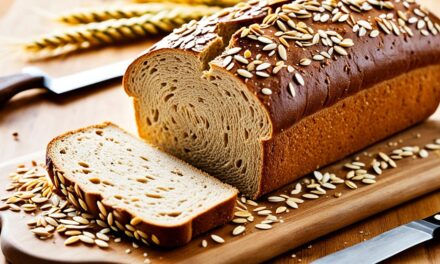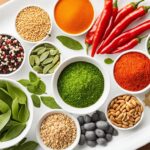Did you know that chronic pain affects approximately 20% of adults worldwide? It can have a debilitating impact on daily life, affecting everything from mobility to mental well-being. If you’ve been searching for natural remedies for chronic pain, you may be surprised to learn that relief could be found in your kitchen.
Recent studies have shown that following an anti-inflammatory diet can be a game-changer when it comes to managing chronic pain. By incorporating specific foods into your daily meals, you can potentially experience a significant reduction in pain levels and improve your overall quality of life.
An anti-inflammatory diet focuses on consuming whole, nutrient-dense foods that are rich in antioxidants and help reduce inflammation in the body. By fueling your body with fruits, vegetables, fatty fish, nuts, seeds, olive oil, and spices like turmeric, you provide it with the necessary nutrients to combat chronic inflammation and support healing.
In this article, we will explore the benefits of an anti-inflammatory diet for chronic pain relief, discuss the link between chronic pain and inflammation, and provide practical tips on implementing this powerful approach to pain management.
Key Takeaways:
- An anti-inflammatory diet can provide natural relief from chronic pain
- By incorporating foods rich in antioxidants, such as fruits, vegetables, and fatty fish, you can reduce inflammation and promote healing.
- Eating a balanced diet and eliminating foods that promote inflammation are crucial steps in managing chronic pain naturally.
- Creating an anti-inflammatory meal plan and working with a nutritionist can help you stay on track and tailor the diet to your specific needs.
- Adopting an anti-inflammatory diet is a holistic approach to pain management that can improve overall well-being.
The Link Between Chronic Pain and Inflammation
Chronic pain and inflammation go hand in hand. When your body experiences an injury or infection, it triggers an inflammatory response as a natural healing mechanism. Inflammation helps to repair damaged tissues and fight off pathogens, playing a crucial role in the recovery process. However, if inflammation persists for an extended period, it can lead to chronic pain and discomfort.
Chronic inflammatory diseases, such as rheumatoid arthritis, fibromyalgia, and inflammatory bowel disease, can have a significant impact on your quality of life. These conditions involve an overactive inflammatory response, causing ongoing pain and inflammation in various parts of the body.
Reducing inflammation is key to managing chronic pain effectively. By adopting an anti-inflammatory diet, you can make a positive impact on your pain levels and overall health. An anti-inflammatory diet focuses on consuming foods that help reduce inflammation and promote healing.
“Inflammation is the body’s response to injury or infection, but when it becomes chronic, it can cause ongoing pain and discomfort.” – Dr. Emily Jones
An anti-inflammatory diet typically includes a variety of fruits, vegetables, fatty fish, nuts, seeds, olive oil, and spices such as turmeric. These foods are rich in antioxidants and offer numerous health benefits, helping to decrease inflammation and alleviate pain.
By incorporating anti-inflammatory foods into your daily meals, you can experience relief from chronic pain and improve your overall well-being. The table below highlights some key inflammatory foods to include in your diet:
| Foods to Include | Foods to Avoid |
|---|---|
|
|
The Benefits of an Anti-Inflammatory Diet for Chronic Pain Relief
An anti-inflammatory diet offers a host of benefits for naturally reducing chronic pain. By incorporating foods rich in antioxidants, you can effectively reduce inflammation in the body and find relief from pain. Fruits and vegetables, especially those with vibrant colors, are excellent sources of antioxidants and should be a staple in your anti-inflammatory diet. Not only do they provide essential nutrients, but they also help combat inflammation and manage pain.
One of the key components of an anti-inflammatory diet is omega-3 fatty acids, which have been shown to have remarkable anti-inflammatory properties. Fatty fish like salmon and sardines are excellent sources of omega-3s and can help alleviate chronic pain. Including these fish in your diet regularly can provide you with the necessary nutrients to reduce inflammation and manage pain effectively.
Nuts and seeds, such as walnuts, almonds, and flaxseeds, are also great additions to an anti-inflammatory diet. They are rich in healthy fats and antioxidants, which play a vital role in reducing inflammation and supporting overall well-being. The anti-inflammatory properties of olive oil and spices like turmeric further enhance the pain-relieving benefits of an anti-inflammatory diet.
By adopting an anti-inflammatory diet, you not only address chronic pain naturally but also prevent the onset of various diseases. Chronic inflammation has been linked to a plethora of health conditions, including heart disease, diabetes, and certain types of cancer. By reducing inflammation through your diet, you can potentially reduce the risk of developing these diseases and promote a healthier life.
So, if you’re looking for a natural way to alleviate chronic pain and improve your overall health, an anti-inflammatory diet is worth considering. By incorporating antioxidant-rich foods, omega-3 fatty acids, and anti-inflammatory spices into your meals, you can reduce pain, prevent disease, and take charge of your well-being.
Implementing an Anti-Inflammatory Diet
Ready to take control of your well-being by implementing an anti-inflammatory diet? It’s time to make conscious choices that will nourish your body and reduce inflammation. With a few simple tips, you can easily create an anti-inflammatory meal plan and incorporate anti-inflammatory foods into your daily meals.
Mindful Choices for a Healthier You
Start by incorporating a variety of fruits and vegetables into your daily diet. Aim for at least nine servings per day to ensure you’re getting a wide range of vitamins, minerals, and antioxidants. These powerhouse foods help combat inflammation and provide essential nutrients for your body’s healing processes.
Don’t forget to include healthy fats in your meals. Fatty fish like salmon and sardines are excellent sources of omega-3 fatty acids, which have been shown to have anti-inflammatory properties and contribute to pain relief. Add nuts, seeds, and olive oil to your diet as well, as they are rich in healthy fats and promote overall well-being.
It’s equally important to be mindful of foods that can promote inflammation. Limit your consumption of processed foods, refined sugars, and trans fats, as these can aggravate inflammation in your body. By making these conscious choices, you can significantly reduce the inflammatory response in your system.
Create an Anti-Inflammatory Meal Plan
Creating an anti-inflammatory meal plan can help you stay on track and ensure that you’re consuming a balanced diet. Start by incorporating the anti-inflammatory foods mentioned earlier into your plan and build your meals around them. Get creative with your recipes, experiment with flavors, and prioritize whole, unprocessed ingredients.
To take it a step further, consider working with a registered dietitian or nutritionist to develop a personalized meal plan that suits your specific needs and preferences. They can guide you on portion sizes, recommend additional anti-inflammatory foods, and provide expert advice on achieving optimal nutrition while managing chronic pain.
Keep Up the Momentum
Implementing an anti-inflammatory diet is not a quick fix, but a long-term lifestyle change. Be consistent with your choices, and don’t be too hard on yourself if you slip up occasionally. Remember, every small step you take toward incorporating anti-inflammatory foods into your meals is a positive move toward pain relief and improved well-being.
So what are you waiting for? Take charge of your health and start implementing an anti-inflammatory diet today. Your body will thank you!
Conclusion
So, there you have it! An anti-inflammatory diet can be your secret weapon in the battle against chronic pain. By embracing the power of nutrition and incorporating anti-inflammatory foods into your daily meals, you have the potential to experience a significant reduction in pain and a boost in overall well-being.
But remember, it’s not just about what you eat. Taking a holistic approach to pain management is key. Consider the role of nutrition as a vital component in reducing inflammation and supporting your body’s natural healing processes. It’s about creating a lifestyle that nurtures your body from the inside out.
So why wait? Start your anti-inflammatory journey today by swapping out those inflammation-triggering foods and embracing a wide variety of fruits, vegetables, fatty fish, nuts, seeds, olive oil, and spices like turmeric. With each colorful, nutrient-packed bite, you’re taking a proactive step towards managing your chronic pain naturally and optimizing your health.
FAQ
Can an anti-inflammatory diet really help with chronic pain relief?
What types of foods should I include in an anti-inflammatory diet?
How does an anti-inflammatory diet work to relieve chronic pain?
Can an anti-inflammatory diet help with other health conditions besides chronic pain?
How can I implement an anti-inflammatory diet in my daily life?
MORE SOURCES TO READ:
- https://www.healthline.com/nutrition/anti-inflammatory-diet-101
- https://www.ncbi.nlm.nih.gov/pmc/articles/PMC10381948/
- https://www.arthritis.org/health-wellness/healthy-living/nutrition/anti-inflammatory/the-ultimate-arthritis-diet
![]()














Recent Comments